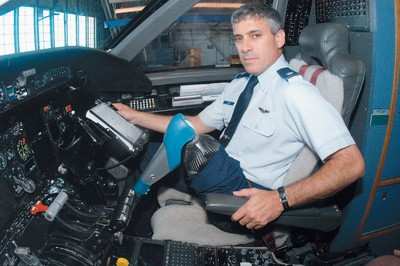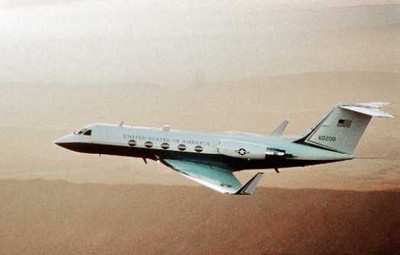Air Force Amputee Returns To Flight Status
Lt. Col. Andrew Lourake (USAF) is about to go flying again.
After a long personal struggle, Lt. Col. Andrew Lourake, the
Commander’s Action Group chief at Andrews AFB (MD), has been
medically cleared to return to flight status. It marks the first
time an above-the-knee amputee has been cleared for the cockpit by
the USAF.

The Air Force surgeon general, Lt. Gen. George Peach Taylor,
medically cleared Colonel Lourake on June 18. This came after a
battery of medical and mobility tests in San Antonio.
The only thing standing between Colonel Lourake and a pilot seat
now is the wait for a formal training slot to open so he can get
requalified to fly.
"(This will set a) great precedence for the Air Force," said
Brig. Gen. Scott Gray, 89th Airlift Wing commander. "It shows how
well the Air Force takes care of their own and how far technology
has come to enable this to happen."
While a lost limb used to mean a discharge for US service
members, breakthroughs in high-tech prosthetics are allowing
service members to fight their way back to active duty.
"Americans would be surprised to learn that a grievous injury,
such as the loss of a limb, no longer means forced discharge,"
President George W. Bush said. "In other words, the medical care is
so good, and the recovery process is so technologically advanced
that people are no longer forced out of the military."
Colonel Lourake’s tenure as a pilot ended Oct. 31, 1998,
when the throttle on his motocross bike got stuck, and his bike was
thrown on top of him, fracturing his left leg.
While in the hospital, he caught a hospital-borne staph
infection, which eventually seeped into the bone. During the next
three and a half year’s, Colonel Lourake received 18
surgeries to repair his infected leg; however, nothing could stop
the pain, and his leg was fused straight with a steel rod.
"At first I didn’t want to have my leg amputated," Colonel
Lourake said. "But after years of being in pain, I knew there
wasn’t any other choice."
Colonel Lourake researched prosthetics and discovered the C-Leg.
It is a computerized artificial limb that can analyze movement at
the rate of 50 messages per second and is able to adjust to changes
in terrain the wearer is walking on.
The C-Leg made Colonel Lourake’s decision to have his leg
amputated a lot easier, he said. In 2002, he became the first US
service member to be fitted with a C-Leg.
After the surgery, he underwent more than 500 hours of physical
therapy.
"There have been a lot of challenges," Colonel Lourake said.
"Having all your limbs then going to missing one creates a learning
curve. You have to start over."
Once he felt he was able to accomplish the physical therapy
tasks on his own, Colonel Lourake quit going.
Now that he has finished physical therapy and been medically
cleared to return to the flight deck, Colonel Lourake said it feels
as though "a long road is coming to an end. … I am getting
back to where I was pre-amputation."
After Colonel Lourake became an amputee, he began trips to
nearby Walter Reed Army Medical Center two to three times per week
to visit with and encourage service members returning from Iraq and
Afghanistan who have lost limbs.
"I feel as though I have been thrust into being a role model for
other people with disabilities," Colonel Lourake said. "I am able
to show them they can achieve what they want, if they put their
mind to it."
Before his accident, Colonel Lourake served as a special-air
missions pilot for the 99th Airlift Squadron. During this time, he
logged more than 1,000 hours flying foreign dignitaries and various
heads of state. After he completes formal training, he will return
to the role.

"(I am) 100-percent confident that Colonel Lourake will be as
great of a pilot as he was before his injury and will strengthen
our crew force," General Gray said.
Now that Colonel Lourake’s goal of returning to the flight
deck is nearly met, he said his next goal is to be the best pilot
he can possibly be.
Colonel Lourake said he is thankful to Air Force and to those
who have supported him.
"I’ve had a huge amount of support from my commanders,
squadron members and doctors," he said. "I didn’t get to this
point without the team effort. To me, this whole experience
solidifies the Air Force is one big family."
(ANN salutes Staff Sgt. April Lapetoda, 89th Airlift Wing
Public Affairs, USAF)
 ANN's Daily Aero-Linx (05.06.25)
ANN's Daily Aero-Linx (05.06.25) ANN's Daily Aero-Term (05.06.25): Ultrahigh Frequency (UHF)
ANN's Daily Aero-Term (05.06.25): Ultrahigh Frequency (UHF) ANN FAQ: Q&A 101
ANN FAQ: Q&A 101 Classic Aero-TV: Virtual Reality Painting--PPG Leverages Technology for Training
Classic Aero-TV: Virtual Reality Painting--PPG Leverages Technology for Training Airborne 05.02.25: Joby Crewed Milestone, Diamond Club, Canadian Pilot Insurance
Airborne 05.02.25: Joby Crewed Milestone, Diamond Club, Canadian Pilot Insurance




